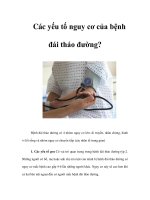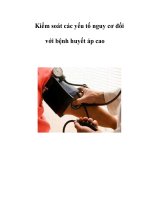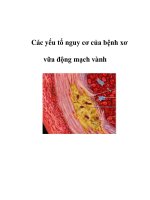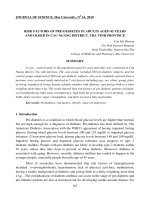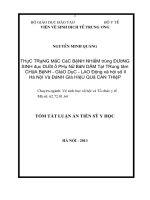Kiểm soát các hành vi nguy cơ của bệnh không lây nhiễm trong quân đội năm 2014_Risk taking behaviours of non communicable diseases among military community in 2014
Bạn đang xem bản rút gọn của tài liệu. Xem và tải ngay bản đầy đủ của tài liệu tại đây (633 KB, 27 trang )
8/7/18
RISK TAKING BEHAVIOURS OF
NON-COMMUNICABLE DISEASES AMONG
MILITARY COMMUNITY IN 2014
Presented by
Dr. Nyan Sint Htun
M.B.,B.S, M.Med.Sc (Health Care Management)
Assistant Lecture, Preventive and Social Medicine Department
Defence Services Medical Academy, Myanmar
1
8/7/18
CONTENTS
1. Introduction
2. Problem Statement & Justification
3. Research Objectives & Methodology
4. Results
5. Discussion and conclusion
6.
6. References
References
2
8/7/18
1. INTRODUCTION
Non-communicable diseases (NCDs) are the leading
cause of adult mortality and morbidity worldwide
including the Southeast Asia region (SEAR).
NCDs are preventable diseases
The challenges lie in reducing the avoidable deaths
and disabilities related to NCDs as much as possible
with the available resources.
3
8/7/18
2. PROBLEM STATEMENT &
JUSTIFICATION
NCDs are a growing public health emergency.
Worldwide, NCDs kill over 35 million people each year,
(representing nearly two-thirds of the world’s deaths)
and one-third of those deaths occur before age 60.
As Myanmar moves on the path of socioeconomic
development and changing lifestyle, there is a shift in
epidemiological transition towards NCDs
4
8/7/18
According to National Survey (2009) reported the
following table is shown:
Gender
Prevalence
Male
Female
Smoker
33.6%
6.1%
Hypertension
31%
29.3%
Overweight
(BMI ≥25kg/m2)
21.85%
23.07%
Obesity
(BMI ≥30kg/m2)
4.3%
8.4%
5
8/7/18
3. RESEARCH OBJECTIVES
METHODOLOGY
General
Objective
To study the risk taking behaviors of noncommunicable diseases among military personnel
and their family members in selected military units
6
8/7/18
Specific Objective
1.
To explore the socio-demographic characteristics of
respondents
To determine the tobacco consumption practice
To determine the alcohol drinking practice
To describe the healthy dietary practice
To identify the BMI, hypertension and diabetes status
To find out relationship between social
demographical characteristics, smoking, betel
chewing, drinking alcohol, dietary pattern with
hypertension, diabetes and BMI
2.
3.
4.
5.
6.
7
8/7/18
RESEARCH METHODOLOGY
Community based cross-sectional descriptive study.
Military personnel and their family members (age group
≥18 years of both sexes) from selected military units.
Seven study areas and collecting the data from 31st May
to 15th June 2014.
Sample size is 1035 respondents from different areas.
Informed consent was also obtained for blood sample
for checking blood glucose level by Glucose test strips.
8
4. RESULTS
A. Age and sex distribution of respondents
A(1). Age distribution of respondents
34.5
35
30
25
20
15
10
5
0
30.3
23.4
11.8
18-25
26-35
36-45
>45
Year
• Mean age = 39.96 ± 10.96 year
• Minimum and maximum age 18 years and 63 years respectively.
9
A(2). Gender distribution of respondents
36.2
male
female
63.8
• Male participants = 375 (36.2%)
• Female participants = 660 (63.8%).
10
B. Distribution of tobacco smoking, betel
chewing and alcohol consumption status
among respondents
Male
Female
Total
Smoker
176(46.9%)
31(4.7%)
207
Non-smoker
199(53.1%)
629 (95.3%)
828
Betel chewer
199(53.1%)
226(34.2%)
425
Non-betel chewer
176(46.9%)
434(65.8%)
610
Alcohol drinker
230(61.3%)
10(1.5%)
240
Non-alcohol drinker
145(38.7%)
650(98.5%)
795
1.Tobacco smoking
2.Betel chewing
3.Alcohol
11
C. Distribution of healthy dietary patterns
and physical activity among respondents
Yes
No
986(98%)
49(2%)
959(92.7%)
76(7.3%)
Palm oil
48.9%
-
Peanut oil
39.3%
-
Vegetable oil
8.4%
-
Other
3.4%
-
43%
57%
1. Fruits eating
2. Vegetables eating
3. Type of cooking oil
4. Doing physical exercises or
sport
12
D. Distribution of Blood pressure, Random blood
glucose and BMI status among Respondents
Number
Percent
Blood pressure (Normal)
809
78.2%
Hypertensive stage (Systolic BP 140 mmHg or
more and Diastolic BP 90 mmHg)
226
21.8%
<180 mg/dl (Normal)
981
94.8%
≥180 mg/dl (Raised Blood Glucose)
54
5.2%
<18.5 (underweight)
94
9.1%
18.5-24.9 (Normal)
635
61.4%
25.0-29.9 (overweight)
238
23.0%
68
6.5%
>29.9 (Obese)
13
8/7/18
E. Association
E.(1) Association between hypertension, diabetes, BMI and
gender
Hypertension
Diabetes
Obese
Obesity
Male
Female
Total
73
(19.5%)
18
(4.8%)
58
(15.5%)
6
(1.6%)
153
(23.2%)
36
(5.5%)
180
(27.3%)
62
(9.4%)
226
(21.8%)
54
(5.2%)
238
(23.0%)
68
(6.6%)
Chi-square
p value
1.9
0.164
0.207
0.649
50.1
<0.001
14
E.(2) association between hypertension, diabetes, BMI and
gender
Smoker
Non-smoker
Alcohol
drinker
Non-alcohol
drinker
Regular
exercises
Not doing
regular
exercises
<18.5
18.5-24.9
25-29.9
>29.9
Total
27
(13.0%)
67
(8.1%)
21
(8.8%)
151
(72.9%)
484
(58.5%)
184
(76.7%)
27 (13.0%)
211
(25.5%)
33
(13.8%)
2
(1.0%)
66
(8.0%)
2
(0.8%)
207
(100%)
828
(100%)
240
(100%)
73
(9.2%)
451
(56.7%)
205
(25.8%)
66
(8.3%)
795
(100%)
45
(10.2%)
287
(64.9%)
91 (20.6%)
19
(4.3%)
442
(100%)
49 (8.3%)
348
(58.7%)
147
(24.8%)
49
(8.3%)
593
(100%)
Chisquare
p value
33.7
<0.001
39.2
<0.001
10.6
<0.014
15
F. Correlation
F(1). Correlation between age of respondents and systolic blood
pressure
r = 0.3,p value <0.01
16
F(2). Correlation between age of respondents and random
blood sugar
r = 0.122, p value <0.001
17
F(3). Correlation between age of respondents and BMI
r = 0.104, p value = 0.001
18
F(4). Correlation between BMI and systolic blood pressure
r = 0.302, p value <0.01
19
F(5). Correlation between BMI and random blood sugar
r = 0.128, p value <0.001
20
5.DISCUSSION
This study found out the risk behaviours of noncommunicable diseases such as tobacco smoking alcohol
drinking, dietary patterns, physical exercises, high blood
pressure and diabetes.
Mean age of this study was 38.9±10.9 years.
Female proportion was more than male proportion which
was similar with the study done in Brazil about risk
behaviours of NCD (Longo GZ et al., 2007)
Prevalence of tobacco smoking was (46.9%) in male (higher
than the National survey,2009) and (4.7%) in female (less
than the National survey,2009) and alcohol drinking was
(61/3%) in male and (5.1%) in female.
21
Almost all of them participants in this study ate fruits and
vegetables in a week, but more than half of participants used
poly-saturated oil because of their socio-economic status
and they even don’t know the danger of poly-saturated oil.
One third of the study population have no physical activity
which was similar to the survey of non-communicable risk
factors done in Nepal.
In our study, male and female ratio of overweight (15.5% &
27.3%) and obesity (1.6% & 9.4%) were different and
higher percentage of obesity in women was found compared
with National Health Survey of Myanmar, 2009.
22
After measuring, 21.8% and 5.2% found raised blood
pressure and raised random blood sugar level respectively.
No obvious different between gender among hypertension
and diabetes in this study which was similar result with
two studies (Oli N et al., 2013 and Timothy S.Laux et al.,
2009).
Male were more common in smoking, betel chewing and
alcohol drinking.
Female were more common to be in overweight and obese
in BMI.
Doing regular exercise is a preventive factor for
overweight and obesity
23
6.CONCLUSION
NCDs are emerging as a public health problem
Survey of risk behaviours of NCDs is essential.
Risk factors were found in one third of the respondents.
Fruits and vegetables consumption was acceptable
although still using poly-saturated oil in their daily cooking
Overweight and obesity still high in this study and female
were more prone to be overweight and obesity
24
7.RECONMENDATION
The
high prevalence of risk factors of non-communicable calls for a
sound public-health approach.
Efforts
should be made to establish surveillance mechanism at the
community level to monitor, evaluate, and guide policies and
programmes.
Multiplicative
nature of risk factors suggests community-based
behavioural and lifestyle-related interventions.
To
reduce the modifiable risk factors, interventions, such as tobacco
control, production and supply of healthy foods, regulation of
unhealthy foods, and urban planning to promote physical activity,
need to be implemented.
25

